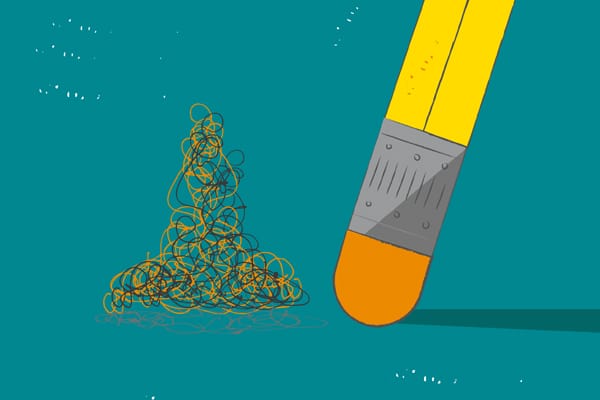How To Maintain A Through-Line To New Innovative Products
There’s a reason TED Talks acquire millions and millions of views: people love stories. But TED talks also count on through-lines for their success — an overall lesson or theme they leave with the audience. The same notion holds true for new innovative products; successful product development is also tied to a clear through-line; in this case, a purpose that fulfills a real, human need. Learn how THRIVE’s design research and product development expertise can help you determine — and maintain — a through-line.
What’s something a successful TED talk and successful product innovation have in common? A through-line. As Chris Anderson, the head of TED, the non-profit organization that curates these talks, explains. A through-line is what the speaker leaves with the audience; it’s the overall lesson or theme behind the story (or stories) you’re telling. Talks without any takeaway may be entertaining, but they don’t give the audience anything to hold onto following the engagement. To deliver a meaningful speech with a through-line — not just one that entertains — a speaker needs to home in on the overarching idea they want to communicate, then make sure all the elements of their talk, bullet by bullet, sentence by sentence, support that idea.
The same notion holds for the development of new innovative products; successful product development is also tied to having a clear through-line. Products and services, whether digital or physical, should serve a purpose that fulfills a real, human need — that’s a product through-line. It has its benefits: At the beginning of an innovation cycle, determining that purpose can help steer development and ensure you don’t end up with something that doesn’t address the initial user need — like a talk that rambles on in different directions without the main idea being apparent. In other words, a substantial through-line/purpose helps you stay focused on your user’s needs and becomes a filter to help you make decisions that lead to more relevant and desirable product designs.
So how do you determine — and maintain — your through-line?
TELL A STORY
Ask yourself: What world are you looking to create for your users?
There’s a reason TED Talks acquire millions and millions of views: people love stories. (There’s science behind it.) And in the development of new innovative products, one of our most potent tools for creating something that connects with consumers is creating stories around how a new product or service will impact their lives. We’ve broken down the four storytelling steps below.
1. Connect with the audience.
Ideally, you have some knowledge of who your strategic target user is. What their needs are, and what needs your products currently address. If not, gather as much as you can from internal sources and secondary research to begin to craft a picture of your consumer. It’s important to know who they are, but it’s even more important to be able to put yourself in their shoes. One way to help yourself embody your consumers’ point of view is to write short narratives about them. For example:
“Susie lives in a prominent suburb of Atlanta with her husband and two children who are a senior and freshman in high school. She’s is not your typical middle-class mom. Susie is a professional triathlete who spends what little free time she has on the road, in the pool or at the gym. She also values family time, so she works hard to juggle hours spent working out and precious moments engaging with her family.”
2. Craft your through-line.
Now that you are thinking from your consumer’s point of view, you can begin to think about what is important to them and what current experiences don’t live up to their desires or expectations. Since we haven’t talked directly to Susie yet, we’ll call these problems that might be worth solving for her “hypotheses.” These hypotheses are all potential through-lines. Think about your consumers’ needs, goals, motivations, and barriers. What is preventing them from achieving their ideal future? What hypotheses can you create around the needs of these consumers that will lead to opportunities for your company to develop new innovative products?
Let’s look at Susie: Based on her brief narrative, we could conclude that she has a goal to maximize time with her family. Her motivation might be that her children will be off to college soon, so she wants to spend quality time with them while they still live at home. A barrier might be that she has a competition coming up, and she is in the thick of training, so she doesn’t have the time or energy to plan family activities. One way to capture this idea is in writing an “I want” statement. For example: “I want to maximize my time with my family because my children will be moving away for college soon, but I don’t have the time or energy to plan family activities.” These statements are always written from the perspective of your strategic target, and form your working hypotheses for the development of new innovative products.
I’m giving you full permission to go for quantity over quality at this stage! How many “I want” statements can you crank out based on what you know about your consumers? Each statement alone could result in a variety of different solutions…but let’s not jump to solutions just yet. You first need to understand better what hypotheses are going to have the most positive impact on your consumers’ experience, as well as your bottom line.
After generating a bunch of “I want” statements, you’ll need to evaluate the opportunities and solutions through the lens of business feasibility and viability. Focusing on these two criteria keeps you honest, making sure you are directing your efforts on potential new offerings that have a high potential for success. Establishing through-lines from your customers’ perspective will ensure real meaning is delivered to your end-user, which in turn translates into new value creation for your business. Mutually beneficial transactions like this will help guide your innovation efforts down a successful path.
3. Get feedback – and work out the kinks.
Great stories (TED talks or otherwise) get better with each telling. That’s because feedback from others helps shape our stories – illuminating which ideas aren’t clear or which points fall flat. The successful development of new innovative products requires feedback from others too. This type of feedback comes from getting in front of consumers and talking to them directly through primary user research. Your goal in talking to consumers is to validate your through-line, but moreover, ensure consumers identify with the world you hope to create for them. Do they see the value and meaning you’ll deliver to them as a “must-have?” Do they feel the problems you’ve chosen to focus on are worth solving?
There are many ways to get feedback from consumers — reach out to THRIVE for more information on what makes sense for your business needs and timeline — but we’ll stay in the fuzzy front end for our purposes. When we’re in this messy upfront part of innovation, a great way to get early feedback from consumers is to take them through a guided research process. Make sure you are making it generative, empowering consumers to co-create their ideal future without being impacted by the bias by your initial hypotheses. We use ethnography and one-on-one in-depth interviews (IDI’s) to uncover the human truths of a particular segment or strategic target. Focus your research questions on being open-ended (never lead or direct) and develop tools and props that give consumers the ability to be creative, but always probe your initial hypotheses to understand the reasoning and motivations behind their behavior better. We take the outcomes of this type of research and make them highly visual in the form of a series of maps to deliver enormous amounts of data in an easy to read and visually compelling way. Examples of such maps would be an Ideal User Experience Map, a Consumer Environment Map, or an Opportunity Framework. These maps are visual representations of your through-line and guide the next phase of work, the ideation and creation of potential new innovative products.
You may be thinking, why can’t we go into this research without taking the time and effort to generate a bunch of through-line hypotheses that we might change or throw away later? Well, solving a complex problem is like embarking on a journey, and having an initial hypothesis is like having a problem-solving map to take you from issue to solution. Think of it as figuring out the resolution to a question before you start. Counterintuitive? Yes, but you do it all the time in your daily life: navigating your way around an unfamiliar part of town, ordering from a menu you have just seen for the first time. You quickly form a hypothesis that informs your decision making in each of these cases. Going into research blind without some idea of what you’re looking for can make you rudderless, asking the wrong questions and leading to potential missed opportunities. Chances are parts of your through-line hypotheses will be correct, helping to guide the conversation to create a detailed and actionable understanding of the problems worth solving from your consumers’ point of view. A working hypothesis is there to be proven or unproven, and that is its power. Never go in-field without at least one!
4. Bring your story to life.
I say that like it’s easy. But hopefully, after gaining the confidence that you are solving the right problems for your consumers, it will be easier to consistently make user-centered decisions and maintain focus on your through-line as the product development process progresses.
Never lose focus on your consumers’ needs. Frame your solution — and every component of your design — on solving their pain-points, and build your product story around them. By the end, you’ll have created a clear takeaway for your user: a product that speaks directly to consumers, their values and beliefs, and solving their real problems with the potential to create meaningful change in their lives.
Ready to get out there and find your through-line? At THRIVE, we can help you find actionable insights about your consumer and develop a solution with a through-line grounded in consumer desirability and need. Contact us today to talk about our design research and industrial design expertise, and how we can help guide innovation down a successful path.







